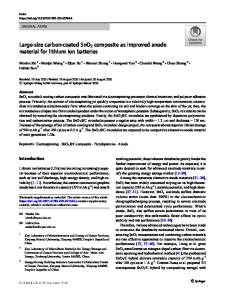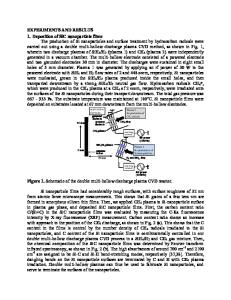Facile synthesis of Fe-based metal-organic framework and graphene composite as an anode material for K-ion batteries
- PDF / 1,965,548 Bytes
- 9 Pages / 595.276 x 790.866 pts Page_size
- 108 Downloads / 397 Views
ORIGINAL PAPER
Facile synthesis of Fe-based metal-organic framework and graphene composite as an anode material for K-ion batteries Qijiu Deng 1 & Zongbin Luo 1 & Haixuan Liu 1 & Yangyang Zhou 1 & Chi Zhou 1 & Rong Yang 2 & Liangliang Wang 3 & Yinglin Yan 2 & Yunhua Xu 1,4 Received: 21 June 2020 / Revised: 17 July 2020 / Accepted: 6 August 2020 # Springer-Verlag GmbH Germany, part of Springer Nature 2020
Abstract We have reported an iron-based metal-organic framework (MOF-235) and graphene composite as a suitable anode host in the upcoming K-ion batteries. The bulk MOF-235 delivers poor K-storage performance and large electrochemical polarization due to its inherent poor electronic conductivity. Accordingly, a modified hydrothermal reaction was performed to contrast a MOF-235 and graphene (G) composite and the as-prepared MOF-235+20G composite could deliver a remarkable capacity of 180 mAh/g over 200 cycles at a current density of 200 mA/g. Due to the addition of the two-dimensional layered conductive graphene, the electronic conductivity of the composite could be significantly improved. And the MOF-235 single crystal can be evenly embedded in the surface or interlayer of graphene to prevent the agglomeration phenomenon of the active material. Furthermore, the active material can be fully utilized during charging and discharging processes which is more conductive to the rapid transport of K+ and electron. Keywords Metal-organic framework . K-ion battery . Graphene . Electrochemical performance
Introduction Rechargeable lithium-ion (Li-ion) batteries have become the most widely studied and commercialized chemical power sources nowadays due to their high energy density, excellent cycling performance, and splendid safety property [1–4]. However, the reserves of lithium in the crust are rather limited, Electronic supplementary material The online version of this article (https://doi.org/10.1007/s11581-020-03735-x) contains supplementary material, which is available to authorized users. * Qijiu Deng [email protected] * Liangliang Wang [email protected] 1
International Research Center for Composite and Intelligent Manufacturing Technology, School of Materials Science and Engineering, Xi’an University of Technology, Xi’an 710048, China
2
School of Science, Institute of Chemical Power Sources, Xi’an University of Technology, Xi’an 710048, China
3
School of Mechanical and Electrical Engineering, Xi’an University of Architecture and Technology, Xi’an 710055, China
4
Yulin University, Yulin 719000, China
which is not conducive to the long-term development of secondary ion batteries [5–7]. In recent decades, several new-type substitutes on Li-ion batteries were widely explored and have made significant progress [8–12]. Especially, potassium-ion (K-ion) batteries are expected to become one of the important alternatives due to the abundant resource reserves, the low standard electrode potential of K/K+, and remarkable K-ion transport capability [13, 14]. Importantly, suitable anode hosts play the key
Data Loading...










